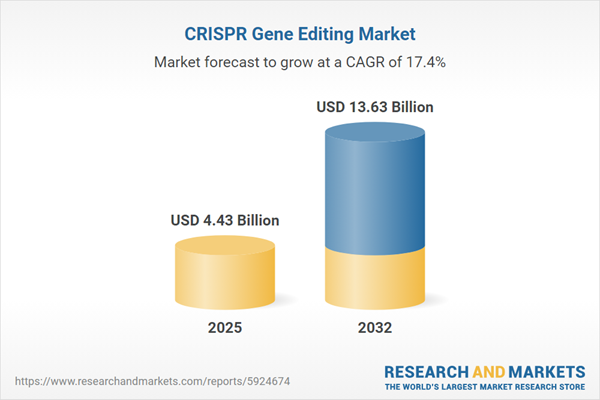Speak directly to the analyst to clarify any post sales queries you may have.
The CRISPR gene editing market is evolving rapidly, reshaping how organizations approach biotechnology, therapeutics, agriculture, and industrial innovation. Senior decision-makers require a comprehensive, actionable view to anticipate market shifts and inform strategic investments in this transformative sector.
Market Snapshot: CRISPR Gene Editing Market Growth and Trends
The CRISPR gene editing market expanded from USD 3.77 billion in 2024 to USD 4.43 billion in 2025, demonstrating robust sector momentum. The market is forecast to sustain strong growth at a CAGR of 17.40%, with projections reaching USD 13.63 billion by 2032. This consistent growth reflects the widespread adoption of CRISPR across multiple verticals and underpins increasing capital allocation, R&D investments, and commercial activities globally.
Scope & Segmentation of the CRISPR Gene Editing Market
This research provides detailed segmentation across the CRISPR gene editing landscape, identifying the most significant technology platforms, application fields, end users, delivery approaches, and regional dynamics influencing future direction.
- Type: Base Editing, Cas9, Cpf1, Prime Editing, Talen, Zfn
- Application: Agriculture (Crop Improvement, Livestock), Industrial & Energy (Bio-based Chemicals, Biofuels), Research & Development (Basic Research, Drug Discovery), Therapeutic (Ex Vivo Therapy—Hematopoietic Stem Cell Therapy, T Cell Therapy; In Vivo Therapy—Oncology, Rare Genetic Disorders)
- End User: Academic & Research Institutes (Public Research Institutes, Universities), Agricultural Companies (Animal Health Companies, Crop Providers), Contract Research Organizations (Clinical Services, Preclinical Services), Pharma & Biotech Companies (Large Pharma, Small & Medium Biotech)
- Delivery Method: Non-Viral Methods (Electroporation, Lipid Nanoparticles, Physical Methods), Vectors (Plasmid Vectors, Viral Vectors)
- Regions: Americas (United States, Canada, Mexico, Brazil, Argentina, Chile, Colombia, Peru), Europe, Middle East & Africa (United Kingdom, Germany, France, Russia, Italy, Spain, Netherlands, Sweden, Poland, Switzerland, United Arab Emirates, Saudi Arabia, Qatar, Turkey, Israel, South Africa, Nigeria, Egypt, Kenya), Asia-Pacific (China, India, Japan, Australia, South Korea, Indonesia, Thailand, Malaysia, Singapore, Taiwan)
- Covered Companies: Thermo Fisher Scientific Inc., Merck KGaA, Danaher Corporation, Agilent Technologies, Qiagen N.V., New England Biolabs, Illumina Inc., GenScript Biotech, Synthego, Takara Bio Inc.
Key Takeaways for Senior Decision-Makers
- New technology modalities such as base and prime editing are expanding the functional range of CRISPR beyond conventional gene knockout, accelerating the pathway from research validation to commercial deployment.
- Therapeutic applications are advancing, particularly in cell and gene therapy pipelines, while agricultural and industrial success stories illustrate CRISPR’s cross-sector versatility for boosting yields and process efficiencies.
- Regulatory frameworks are evolving globally, with North America and Asia-Pacific regions streamlining approval and commercialization, while EMEA continues to emphasize oversight and ethical transparency.
- Strategic alliances among pharmaceutical giants, startups, CROs, and research institutions are driving innovation, helping organizations navigate technical and compliance complexities swiftly.
- A focus on domestic manufacturing and diversified supply chains is increasing resilience in reagent and equipment procurement, in direct response to shifting trade and tariff policies.
- Tailored market strategies are critical. Regional, application, and technological variations require nuanced approaches for stakeholders to remain competitive and compliant.
Tariff Impact: Effects of United States Tariffs on Supply Chains and Collaboration
Recent United States tariffs on gene editing reagents and equipment have led many suppliers to adjust sourcing strategies, encouraging domestic manufacturing and increased focus on supply chain resilience. This has impacted cost structures and led to renegotiated collaborations across academic and industrial partners. Organizations with robust vendor qualification and flexible sourcing are now better positioned to manage volatility while supporting national biotechnology infrastructure goals.
Methodology & Data Sources
The analysis integrates in-depth expert interviews, secondary research from peer-reviewed literature and regulatory filings, and data triangulation techniques. Insights are validated by panels including molecular biologists, bioethicists, and supply chain specialists, and cover perspectives across all major regions and technology segments.
Why This Report Matters for Enterprise Leaders
- Enables executive teams to benchmark technology investments, market positioning, and risk exposure within a dynamic competitive landscape.
- Supports the design of targeted market entry and partnership strategies aligned to regional regulatory and commercial realities.
- Delivers actionable intelligence on how to harness emerging CRISPR opportunities and safeguard operations against potential supply chain disruptions.
Conclusion
The CRISPR gene editing market is entering a phase of rapid expansion and technological refinement. Organizations that align innovation, compliance, and resilient supply strategies will unlock significant new value. Senior stakeholders are urged to leverage these findings to shape confident, future-ready decisions.
Additional Product Information:
- Purchase of this report includes 1 year online access with quarterly updates.
- This report can be updated on request. Please contact our Customer Experience team using the Ask a Question widget on our website.
Table of Contents
3. Executive Summary
4. Market Overview
7. Cumulative Impact of Artificial Intelligence 2025
Companies Mentioned
The companies profiled in this CRISPR Gene Editing market report include:- Thermo Fisher Scientific Inc.
- Merck KGaA
- Danaher Corporation
- Agilent Technologies, Inc.
- Qiagen N.V.
- New England Biolabs, Inc.
- Illumina, Inc.
- GenScript Biotech Corporation
- Synthego, Inc.
- Takara Bio Inc.
Table Information
| Report Attribute | Details |
|---|---|
| No. of Pages | 180 |
| Published | October 2025 |
| Forecast Period | 2025 - 2032 |
| Estimated Market Value ( USD | $ 4.43 Billion |
| Forecasted Market Value ( USD | $ 13.63 Billion |
| Compound Annual Growth Rate | 17.4% |
| Regions Covered | Global |
| No. of Companies Mentioned | 11 |









